Fair Compensation for Part-Time Employees: Analysis of Canadian Market
VerifiedAdded on 2023/06/06
|9
|2249
|479
Report
AI Summary
This report examines the disparities in compensation between full-time and part-time employees in Canada, highlighting the growing concerns within the Canadian employment industry. It discusses how employers, in pursuit of cost benefits, often introduce unethical regulations and pressure on part-time staff, leading to inadequate wages and benefits. The declining part-time employment rate and its negative economic impact are analyzed, referencing historical data and recent trends. The report explores the past and current situations of part-time workers, identifying problems such as unfair working hours, low wages, and lack of benefits. Alternative solutions, including structural growth, technological advancements, and new employment policies, are proposed to address these issues. The report concludes with recommendations for organizational development policies and government monitoring to ensure fair treatment and equal rights for all workers, aiming to improve productivity and job satisfaction in the Canadian workforce. Desklib provides a platform for students to access similar solved assignments and past papers.
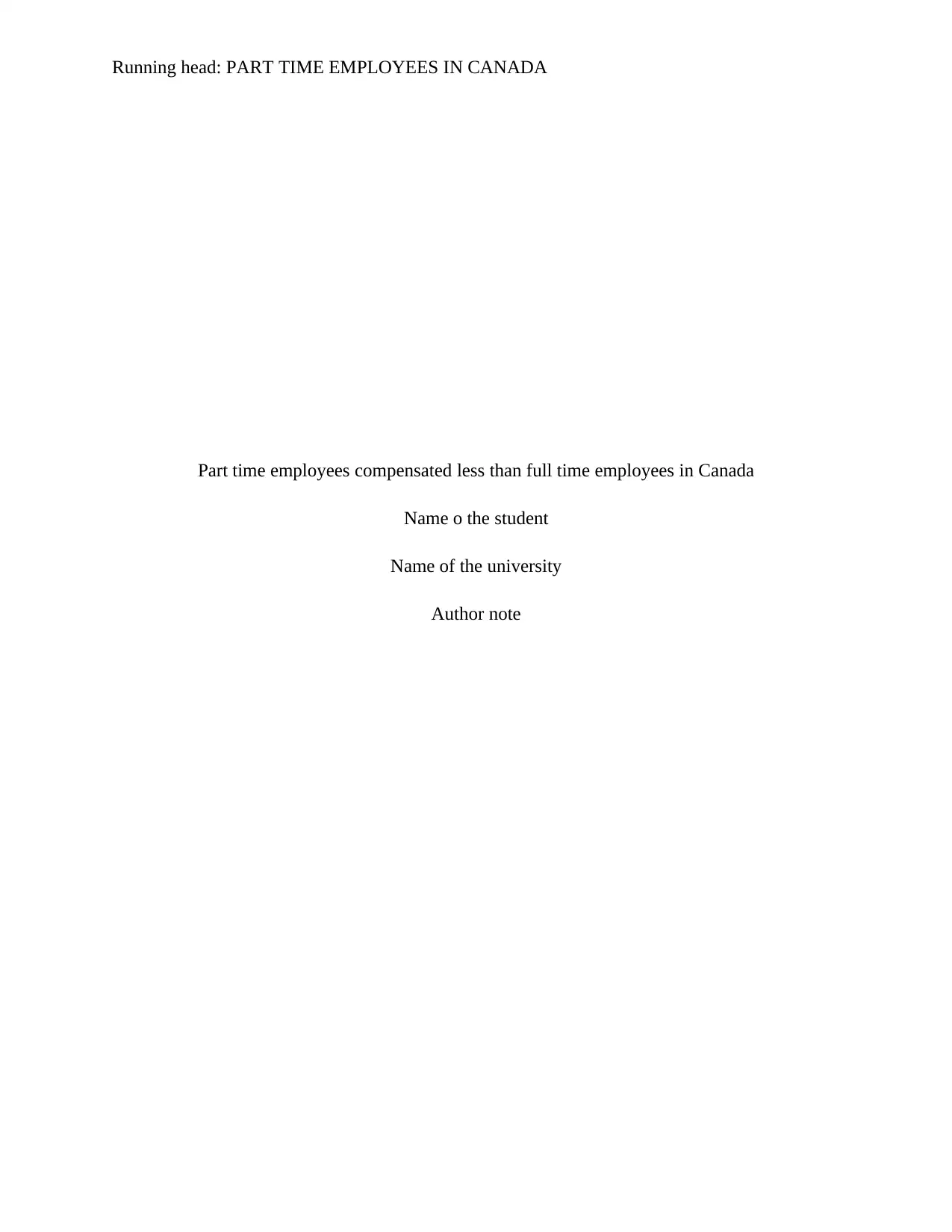
Running head: PART TIME EMPLOYEES IN CANADA
Part time employees compensated less than full time employees in Canada
Name o the student
Name of the university
Author note
Part time employees compensated less than full time employees in Canada
Name o the student
Name of the university
Author note
Paraphrase This Document
Need a fresh take? Get an instant paraphrase of this document with our AI Paraphraser
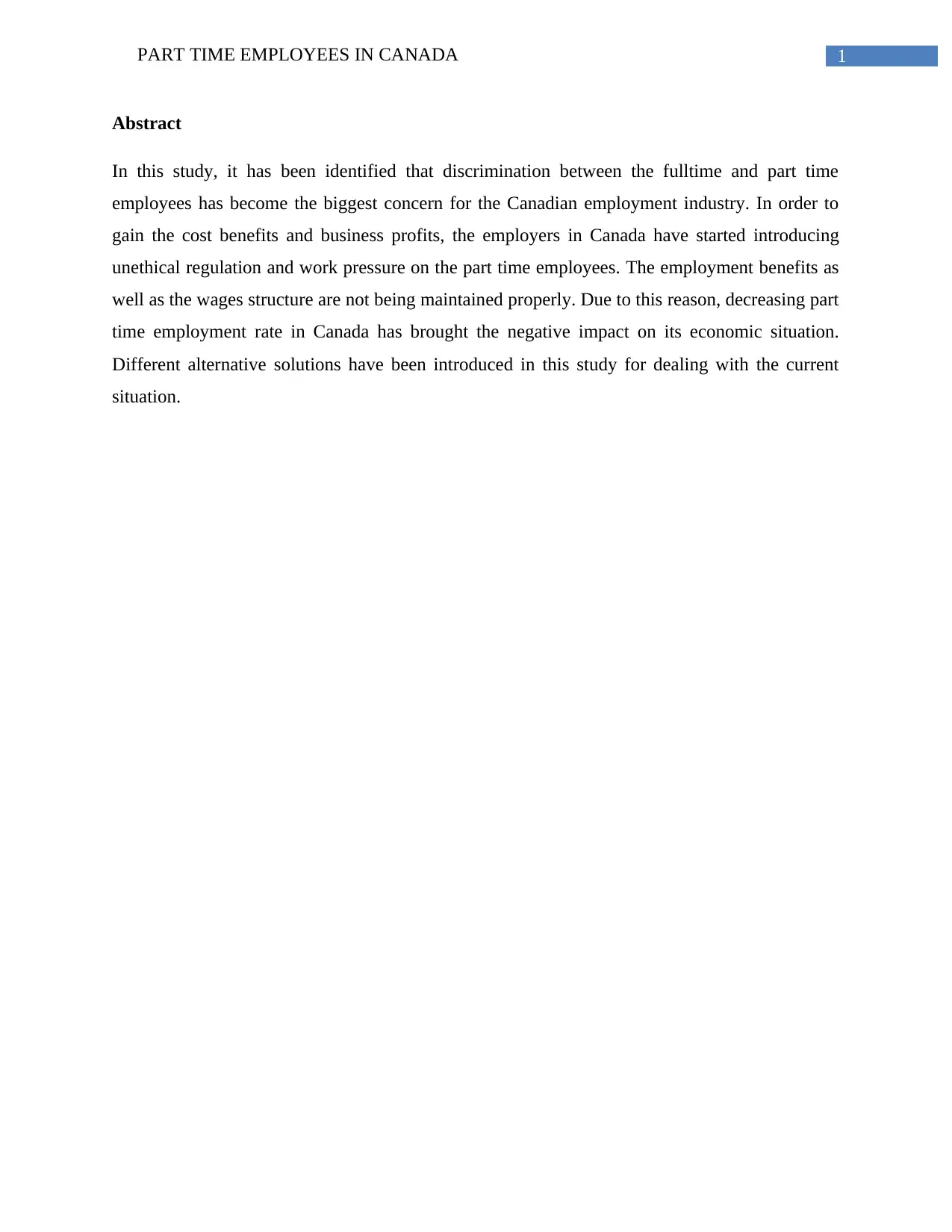
1PART TIME EMPLOYEES IN CANADA
Abstract
In this study, it has been identified that discrimination between the fulltime and part time
employees has become the biggest concern for the Canadian employment industry. In order to
gain the cost benefits and business profits, the employers in Canada have started introducing
unethical regulation and work pressure on the part time employees. The employment benefits as
well as the wages structure are not being maintained properly. Due to this reason, decreasing part
time employment rate in Canada has brought the negative impact on its economic situation.
Different alternative solutions have been introduced in this study for dealing with the current
situation.
Abstract
In this study, it has been identified that discrimination between the fulltime and part time
employees has become the biggest concern for the Canadian employment industry. In order to
gain the cost benefits and business profits, the employers in Canada have started introducing
unethical regulation and work pressure on the part time employees. The employment benefits as
well as the wages structure are not being maintained properly. Due to this reason, decreasing part
time employment rate in Canada has brought the negative impact on its economic situation.
Different alternative solutions have been introduced in this study for dealing with the current
situation.
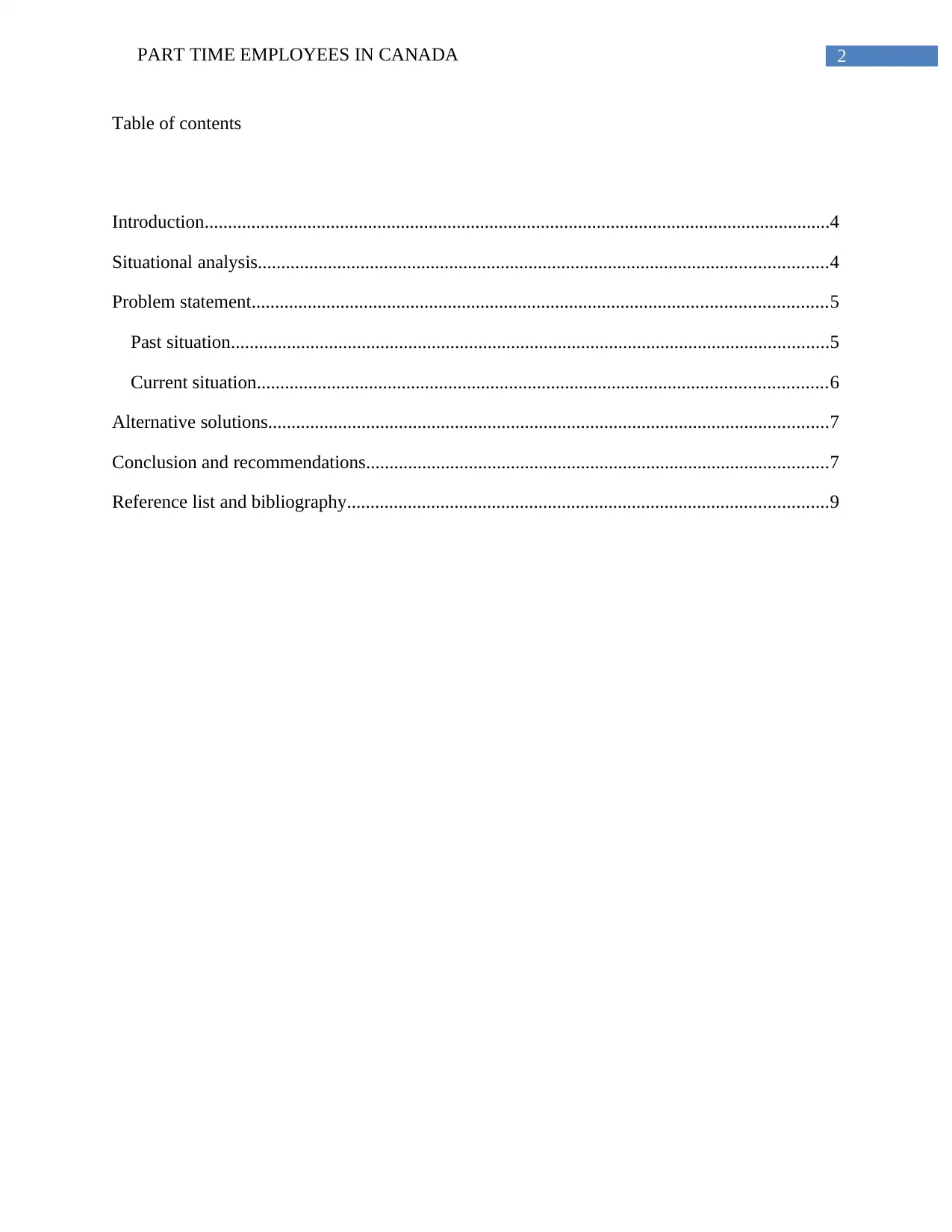
2PART TIME EMPLOYEES IN CANADA
Table of contents
Introduction......................................................................................................................................4
Situational analysis..........................................................................................................................4
Problem statement...........................................................................................................................5
Past situation................................................................................................................................5
Current situation..........................................................................................................................6
Alternative solutions........................................................................................................................7
Conclusion and recommendations...................................................................................................7
Reference list and bibliography.......................................................................................................9
Table of contents
Introduction......................................................................................................................................4
Situational analysis..........................................................................................................................4
Problem statement...........................................................................................................................5
Past situation................................................................................................................................5
Current situation..........................................................................................................................6
Alternative solutions........................................................................................................................7
Conclusion and recommendations...................................................................................................7
Reference list and bibliography.......................................................................................................9
⊘ This is a preview!⊘
Do you want full access?
Subscribe today to unlock all pages.

Trusted by 1+ million students worldwide
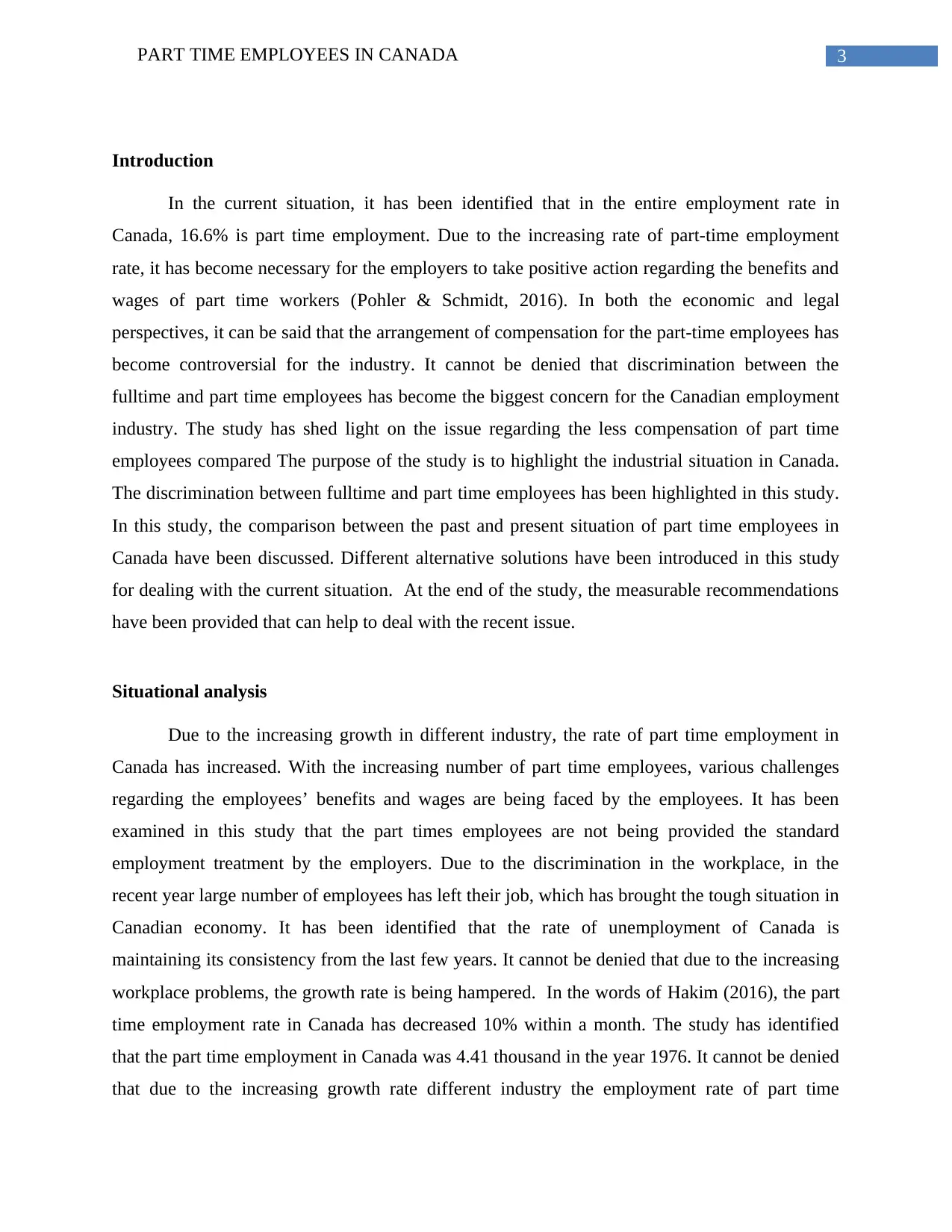
3PART TIME EMPLOYEES IN CANADA
Introduction
In the current situation, it has been identified that in the entire employment rate in
Canada, 16.6% is part time employment. Due to the increasing rate of part-time employment
rate, it has become necessary for the employers to take positive action regarding the benefits and
wages of part time workers (Pohler & Schmidt, 2016). In both the economic and legal
perspectives, it can be said that the arrangement of compensation for the part-time employees has
become controversial for the industry. It cannot be denied that discrimination between the
fulltime and part time employees has become the biggest concern for the Canadian employment
industry. The study has shed light on the issue regarding the less compensation of part time
employees compared The purpose of the study is to highlight the industrial situation in Canada.
The discrimination between fulltime and part time employees has been highlighted in this study.
In this study, the comparison between the past and present situation of part time employees in
Canada have been discussed. Different alternative solutions have been introduced in this study
for dealing with the current situation. At the end of the study, the measurable recommendations
have been provided that can help to deal with the recent issue.
Situational analysis
Due to the increasing growth in different industry, the rate of part time employment in
Canada has increased. With the increasing number of part time employees, various challenges
regarding the employees’ benefits and wages are being faced by the employees. It has been
examined in this study that the part times employees are not being provided the standard
employment treatment by the employers. Due to the discrimination in the workplace, in the
recent year large number of employees has left their job, which has brought the tough situation in
Canadian economy. It has been identified that the rate of unemployment of Canada is
maintaining its consistency from the last few years. It cannot be denied that due to the increasing
workplace problems, the growth rate is being hampered. In the words of Hakim (2016), the part
time employment rate in Canada has decreased 10% within a month. The study has identified
that the part time employment in Canada was 4.41 thousand in the year 1976. It cannot be denied
that due to the increasing growth rate different industry the employment rate of part time
Introduction
In the current situation, it has been identified that in the entire employment rate in
Canada, 16.6% is part time employment. Due to the increasing rate of part-time employment
rate, it has become necessary for the employers to take positive action regarding the benefits and
wages of part time workers (Pohler & Schmidt, 2016). In both the economic and legal
perspectives, it can be said that the arrangement of compensation for the part-time employees has
become controversial for the industry. It cannot be denied that discrimination between the
fulltime and part time employees has become the biggest concern for the Canadian employment
industry. The study has shed light on the issue regarding the less compensation of part time
employees compared The purpose of the study is to highlight the industrial situation in Canada.
The discrimination between fulltime and part time employees has been highlighted in this study.
In this study, the comparison between the past and present situation of part time employees in
Canada have been discussed. Different alternative solutions have been introduced in this study
for dealing with the current situation. At the end of the study, the measurable recommendations
have been provided that can help to deal with the recent issue.
Situational analysis
Due to the increasing growth in different industry, the rate of part time employment in
Canada has increased. With the increasing number of part time employees, various challenges
regarding the employees’ benefits and wages are being faced by the employees. It has been
examined in this study that the part times employees are not being provided the standard
employment treatment by the employers. Due to the discrimination in the workplace, in the
recent year large number of employees has left their job, which has brought the tough situation in
Canadian economy. It has been identified that the rate of unemployment of Canada is
maintaining its consistency from the last few years. It cannot be denied that due to the increasing
workplace problems, the growth rate is being hampered. In the words of Hakim (2016), the part
time employment rate in Canada has decreased 10% within a month. The study has identified
that the part time employment in Canada was 4.41 thousand in the year 1976. It cannot be denied
that due to the increasing growth rate different industry the employment rate of part time
Paraphrase This Document
Need a fresh take? Get an instant paraphrase of this document with our AI Paraphraser
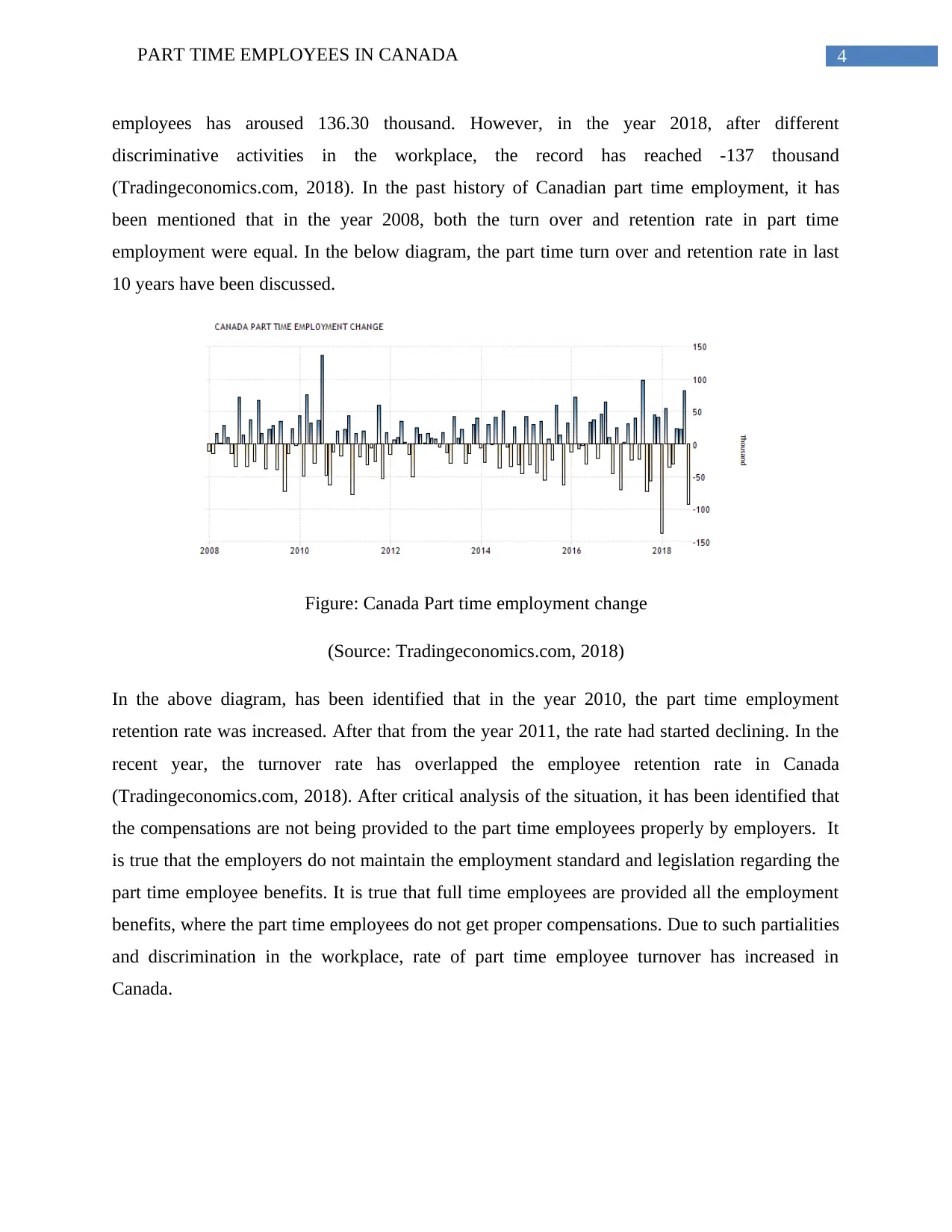
4PART TIME EMPLOYEES IN CANADA
employees has aroused 136.30 thousand. However, in the year 2018, after different
discriminative activities in the workplace, the record has reached -137 thousand
(Tradingeconomics.com, 2018). In the past history of Canadian part time employment, it has
been mentioned that in the year 2008, both the turn over and retention rate in part time
employment were equal. In the below diagram, the part time turn over and retention rate in last
10 years have been discussed.
Figure: Canada Part time employment change
(Source: Tradingeconomics.com, 2018)
In the above diagram, has been identified that in the year 2010, the part time employment
retention rate was increased. After that from the year 2011, the rate had started declining. In the
recent year, the turnover rate has overlapped the employee retention rate in Canada
(Tradingeconomics.com, 2018). After critical analysis of the situation, it has been identified that
the compensations are not being provided to the part time employees properly by employers. It
is true that the employers do not maintain the employment standard and legislation regarding the
part time employee benefits. It is true that full time employees are provided all the employment
benefits, where the part time employees do not get proper compensations. Due to such partialities
and discrimination in the workplace, rate of part time employee turnover has increased in
Canada.
employees has aroused 136.30 thousand. However, in the year 2018, after different
discriminative activities in the workplace, the record has reached -137 thousand
(Tradingeconomics.com, 2018). In the past history of Canadian part time employment, it has
been mentioned that in the year 2008, both the turn over and retention rate in part time
employment were equal. In the below diagram, the part time turn over and retention rate in last
10 years have been discussed.
Figure: Canada Part time employment change
(Source: Tradingeconomics.com, 2018)
In the above diagram, has been identified that in the year 2010, the part time employment
retention rate was increased. After that from the year 2011, the rate had started declining. In the
recent year, the turnover rate has overlapped the employee retention rate in Canada
(Tradingeconomics.com, 2018). After critical analysis of the situation, it has been identified that
the compensations are not being provided to the part time employees properly by employers. It
is true that the employers do not maintain the employment standard and legislation regarding the
part time employee benefits. It is true that full time employees are provided all the employment
benefits, where the part time employees do not get proper compensations. Due to such partialities
and discrimination in the workplace, rate of part time employee turnover has increased in
Canada.
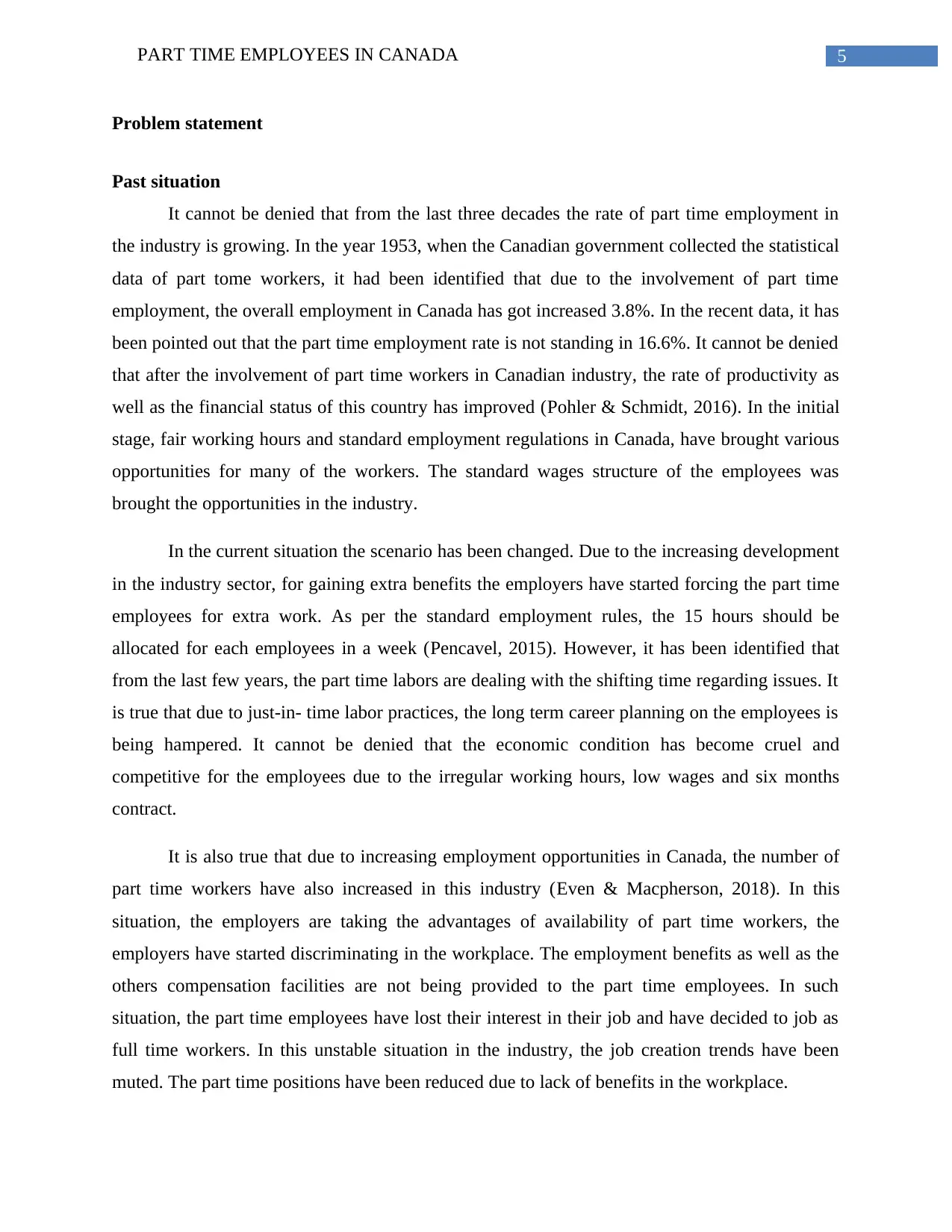
5PART TIME EMPLOYEES IN CANADA
Problem statement
Past situation
It cannot be denied that from the last three decades the rate of part time employment in
the industry is growing. In the year 1953, when the Canadian government collected the statistical
data of part tome workers, it had been identified that due to the involvement of part time
employment, the overall employment in Canada has got increased 3.8%. In the recent data, it has
been pointed out that the part time employment rate is not standing in 16.6%. It cannot be denied
that after the involvement of part time workers in Canadian industry, the rate of productivity as
well as the financial status of this country has improved (Pohler & Schmidt, 2016). In the initial
stage, fair working hours and standard employment regulations in Canada, have brought various
opportunities for many of the workers. The standard wages structure of the employees was
brought the opportunities in the industry.
In the current situation the scenario has been changed. Due to the increasing development
in the industry sector, for gaining extra benefits the employers have started forcing the part time
employees for extra work. As per the standard employment rules, the 15 hours should be
allocated for each employees in a week (Pencavel, 2015). However, it has been identified that
from the last few years, the part time labors are dealing with the shifting time regarding issues. It
is true that due to just-in- time labor practices, the long term career planning on the employees is
being hampered. It cannot be denied that the economic condition has become cruel and
competitive for the employees due to the irregular working hours, low wages and six months
contract.
It is also true that due to increasing employment opportunities in Canada, the number of
part time workers have also increased in this industry (Even & Macpherson, 2018). In this
situation, the employers are taking the advantages of availability of part time workers, the
employers have started discriminating in the workplace. The employment benefits as well as the
others compensation facilities are not being provided to the part time employees. In such
situation, the part time employees have lost their interest in their job and have decided to job as
full time workers. In this unstable situation in the industry, the job creation trends have been
muted. The part time positions have been reduced due to lack of benefits in the workplace.
Problem statement
Past situation
It cannot be denied that from the last three decades the rate of part time employment in
the industry is growing. In the year 1953, when the Canadian government collected the statistical
data of part tome workers, it had been identified that due to the involvement of part time
employment, the overall employment in Canada has got increased 3.8%. In the recent data, it has
been pointed out that the part time employment rate is not standing in 16.6%. It cannot be denied
that after the involvement of part time workers in Canadian industry, the rate of productivity as
well as the financial status of this country has improved (Pohler & Schmidt, 2016). In the initial
stage, fair working hours and standard employment regulations in Canada, have brought various
opportunities for many of the workers. The standard wages structure of the employees was
brought the opportunities in the industry.
In the current situation the scenario has been changed. Due to the increasing development
in the industry sector, for gaining extra benefits the employers have started forcing the part time
employees for extra work. As per the standard employment rules, the 15 hours should be
allocated for each employees in a week (Pencavel, 2015). However, it has been identified that
from the last few years, the part time labors are dealing with the shifting time regarding issues. It
is true that due to just-in- time labor practices, the long term career planning on the employees is
being hampered. It cannot be denied that the economic condition has become cruel and
competitive for the employees due to the irregular working hours, low wages and six months
contract.
It is also true that due to increasing employment opportunities in Canada, the number of
part time workers have also increased in this industry (Even & Macpherson, 2018). In this
situation, the employers are taking the advantages of availability of part time workers, the
employers have started discriminating in the workplace. The employment benefits as well as the
others compensation facilities are not being provided to the part time employees. In such
situation, the part time employees have lost their interest in their job and have decided to job as
full time workers. In this unstable situation in the industry, the job creation trends have been
muted. The part time positions have been reduced due to lack of benefits in the workplace.
⊘ This is a preview!⊘
Do you want full access?
Subscribe today to unlock all pages.

Trusted by 1+ million students worldwide
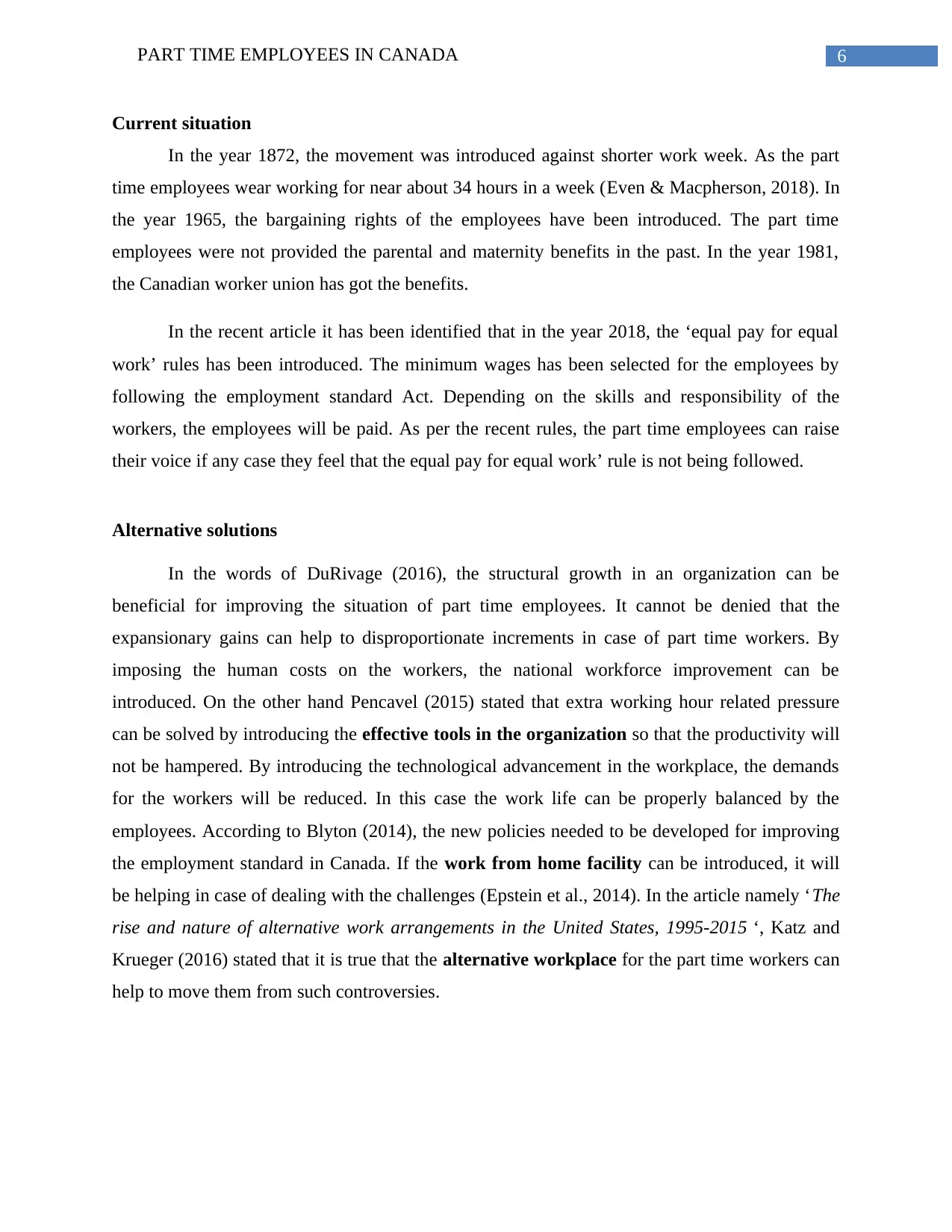
6PART TIME EMPLOYEES IN CANADA
Current situation
In the year 1872, the movement was introduced against shorter work week. As the part
time employees wear working for near about 34 hours in a week (Even & Macpherson, 2018). In
the year 1965, the bargaining rights of the employees have been introduced. The part time
employees were not provided the parental and maternity benefits in the past. In the year 1981,
the Canadian worker union has got the benefits.
In the recent article it has been identified that in the year 2018, the ‘equal pay for equal
work’ rules has been introduced. The minimum wages has been selected for the employees by
following the employment standard Act. Depending on the skills and responsibility of the
workers, the employees will be paid. As per the recent rules, the part time employees can raise
their voice if any case they feel that the equal pay for equal work’ rule is not being followed.
Alternative solutions
In the words of DuRivage (2016), the structural growth in an organization can be
beneficial for improving the situation of part time employees. It cannot be denied that the
expansionary gains can help to disproportionate increments in case of part time workers. By
imposing the human costs on the workers, the national workforce improvement can be
introduced. On the other hand Pencavel (2015) stated that extra working hour related pressure
can be solved by introducing the effective tools in the organization so that the productivity will
not be hampered. By introducing the technological advancement in the workplace, the demands
for the workers will be reduced. In this case the work life can be properly balanced by the
employees. According to Blyton (2014), the new policies needed to be developed for improving
the employment standard in Canada. If the work from home facility can be introduced, it will
be helping in case of dealing with the challenges (Epstein et al., 2014). In the article namely ‘The
rise and nature of alternative work arrangements in the United States, 1995-2015 ‘, Katz and
Krueger (2016) stated that it is true that the alternative workplace for the part time workers can
help to move them from such controversies.
Current situation
In the year 1872, the movement was introduced against shorter work week. As the part
time employees wear working for near about 34 hours in a week (Even & Macpherson, 2018). In
the year 1965, the bargaining rights of the employees have been introduced. The part time
employees were not provided the parental and maternity benefits in the past. In the year 1981,
the Canadian worker union has got the benefits.
In the recent article it has been identified that in the year 2018, the ‘equal pay for equal
work’ rules has been introduced. The minimum wages has been selected for the employees by
following the employment standard Act. Depending on the skills and responsibility of the
workers, the employees will be paid. As per the recent rules, the part time employees can raise
their voice if any case they feel that the equal pay for equal work’ rule is not being followed.
Alternative solutions
In the words of DuRivage (2016), the structural growth in an organization can be
beneficial for improving the situation of part time employees. It cannot be denied that the
expansionary gains can help to disproportionate increments in case of part time workers. By
imposing the human costs on the workers, the national workforce improvement can be
introduced. On the other hand Pencavel (2015) stated that extra working hour related pressure
can be solved by introducing the effective tools in the organization so that the productivity will
not be hampered. By introducing the technological advancement in the workplace, the demands
for the workers will be reduced. In this case the work life can be properly balanced by the
employees. According to Blyton (2014), the new policies needed to be developed for improving
the employment standard in Canada. If the work from home facility can be introduced, it will
be helping in case of dealing with the challenges (Epstein et al., 2014). In the article namely ‘The
rise and nature of alternative work arrangements in the United States, 1995-2015 ‘, Katz and
Krueger (2016) stated that it is true that the alternative workplace for the part time workers can
help to move them from such controversies.
Paraphrase This Document
Need a fresh take? Get an instant paraphrase of this document with our AI Paraphraser
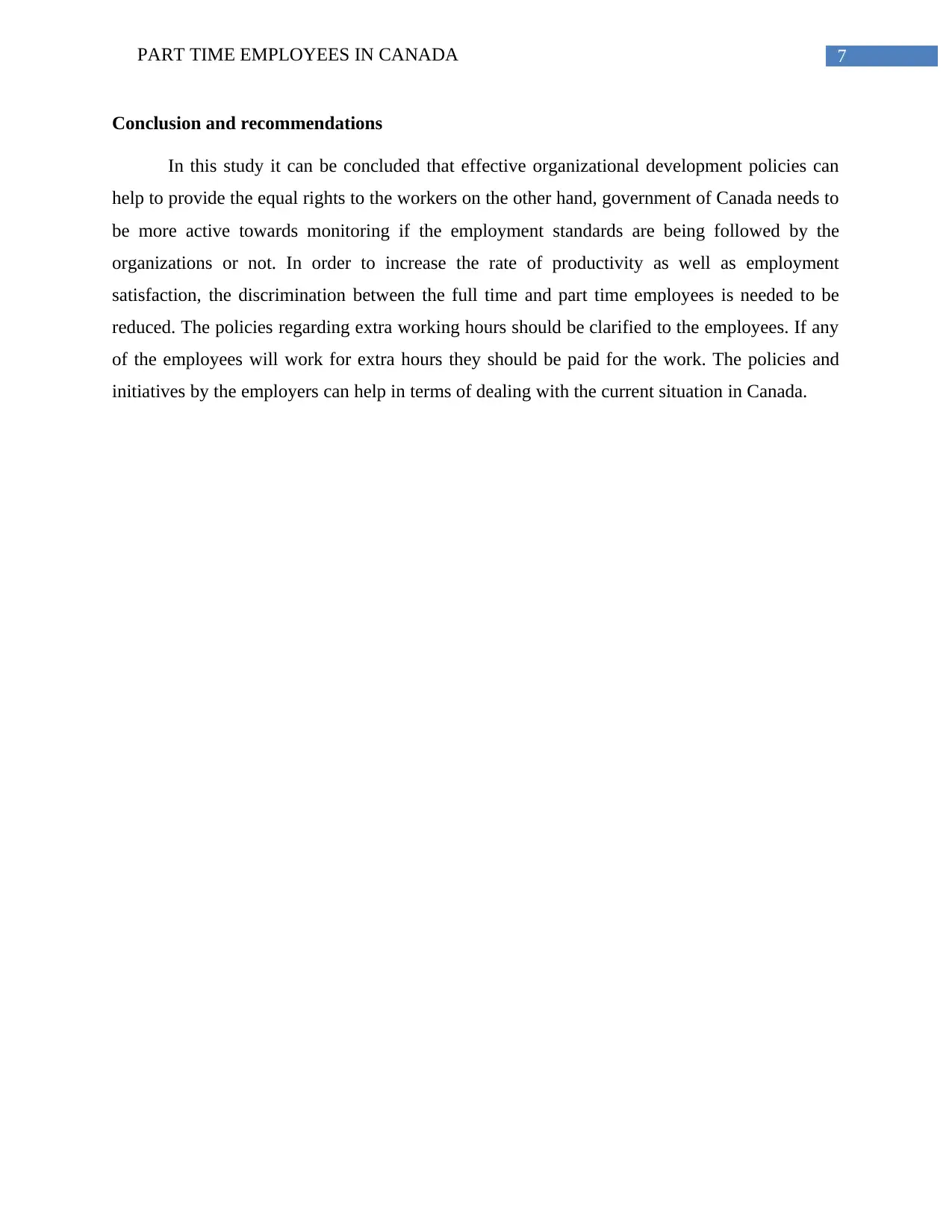
7PART TIME EMPLOYEES IN CANADA
Conclusion and recommendations
In this study it can be concluded that effective organizational development policies can
help to provide the equal rights to the workers on the other hand, government of Canada needs to
be more active towards monitoring if the employment standards are being followed by the
organizations or not. In order to increase the rate of productivity as well as employment
satisfaction, the discrimination between the full time and part time employees is needed to be
reduced. The policies regarding extra working hours should be clarified to the employees. If any
of the employees will work for extra hours they should be paid for the work. The policies and
initiatives by the employers can help in terms of dealing with the current situation in Canada.
Conclusion and recommendations
In this study it can be concluded that effective organizational development policies can
help to provide the equal rights to the workers on the other hand, government of Canada needs to
be more active towards monitoring if the employment standards are being followed by the
organizations or not. In order to increase the rate of productivity as well as employment
satisfaction, the discrimination between the full time and part time employees is needed to be
reduced. The policies regarding extra working hours should be clarified to the employees. If any
of the employees will work for extra hours they should be paid for the work. The policies and
initiatives by the employers can help in terms of dealing with the current situation in Canada.
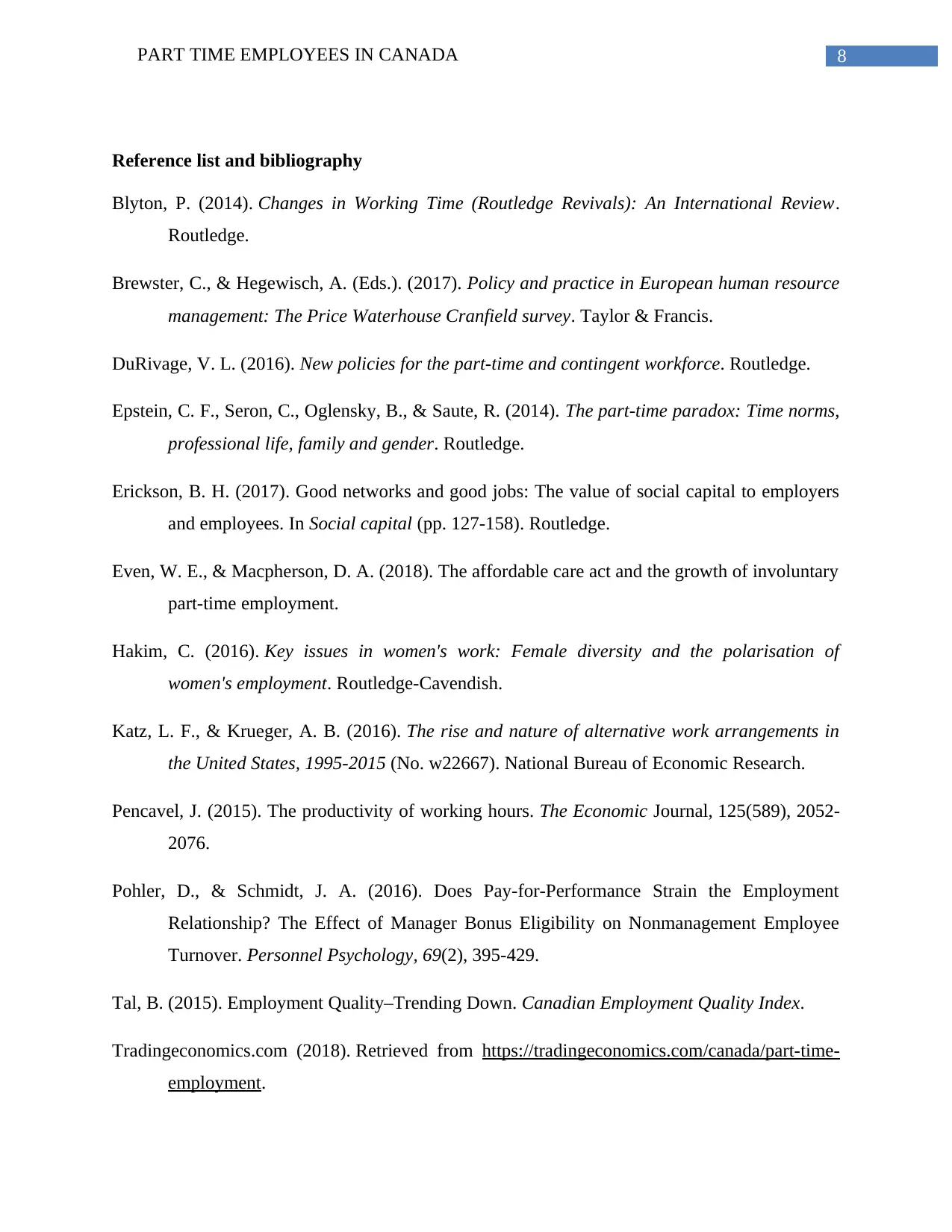
8PART TIME EMPLOYEES IN CANADA
Reference list and bibliography
Blyton, P. (2014). Changes in Working Time (Routledge Revivals): An International Review.
Routledge.
Brewster, C., & Hegewisch, A. (Eds.). (2017). Policy and practice in European human resource
management: The Price Waterhouse Cranfield survey. Taylor & Francis.
DuRivage, V. L. (2016). New policies for the part-time and contingent workforce. Routledge.
Epstein, C. F., Seron, C., Oglensky, B., & Saute, R. (2014). The part-time paradox: Time norms,
professional life, family and gender. Routledge.
Erickson, B. H. (2017). Good networks and good jobs: The value of social capital to employers
and employees. In Social capital (pp. 127-158). Routledge.
Even, W. E., & Macpherson, D. A. (2018). The affordable care act and the growth of involuntary
part-time employment.
Hakim, C. (2016). Key issues in women's work: Female diversity and the polarisation of
women's employment. Routledge-Cavendish.
Katz, L. F., & Krueger, A. B. (2016). The rise and nature of alternative work arrangements in
the United States, 1995-2015 (No. w22667). National Bureau of Economic Research.
Pencavel, J. (2015). The productivity of working hours. The Economic Journal, 125(589), 2052-
2076.
Pohler, D., & Schmidt, J. A. (2016). Does Pay‐for‐Performance Strain the Employment
Relationship? The Effect of Manager Bonus Eligibility on Nonmanagement Employee
Turnover. Personnel Psychology, 69(2), 395-429.
Tal, B. (2015). Employment Quality–Trending Down. Canadian Employment Quality Index.
Tradingeconomics.com (2018). Retrieved from https://tradingeconomics.com/canada/part-time-
employment.
Reference list and bibliography
Blyton, P. (2014). Changes in Working Time (Routledge Revivals): An International Review.
Routledge.
Brewster, C., & Hegewisch, A. (Eds.). (2017). Policy and practice in European human resource
management: The Price Waterhouse Cranfield survey. Taylor & Francis.
DuRivage, V. L. (2016). New policies for the part-time and contingent workforce. Routledge.
Epstein, C. F., Seron, C., Oglensky, B., & Saute, R. (2014). The part-time paradox: Time norms,
professional life, family and gender. Routledge.
Erickson, B. H. (2017). Good networks and good jobs: The value of social capital to employers
and employees. In Social capital (pp. 127-158). Routledge.
Even, W. E., & Macpherson, D. A. (2018). The affordable care act and the growth of involuntary
part-time employment.
Hakim, C. (2016). Key issues in women's work: Female diversity and the polarisation of
women's employment. Routledge-Cavendish.
Katz, L. F., & Krueger, A. B. (2016). The rise and nature of alternative work arrangements in
the United States, 1995-2015 (No. w22667). National Bureau of Economic Research.
Pencavel, J. (2015). The productivity of working hours. The Economic Journal, 125(589), 2052-
2076.
Pohler, D., & Schmidt, J. A. (2016). Does Pay‐for‐Performance Strain the Employment
Relationship? The Effect of Manager Bonus Eligibility on Nonmanagement Employee
Turnover. Personnel Psychology, 69(2), 395-429.
Tal, B. (2015). Employment Quality–Trending Down. Canadian Employment Quality Index.
Tradingeconomics.com (2018). Retrieved from https://tradingeconomics.com/canada/part-time-
employment.
⊘ This is a preview!⊘
Do you want full access?
Subscribe today to unlock all pages.

Trusted by 1+ million students worldwide
1 out of 9
Related Documents
Your All-in-One AI-Powered Toolkit for Academic Success.
+13062052269
info@desklib.com
Available 24*7 on WhatsApp / Email
![[object Object]](/_next/static/media/star-bottom.7253800d.svg)
Unlock your academic potential
Copyright © 2020–2025 A2Z Services. All Rights Reserved. Developed and managed by ZUCOL.





